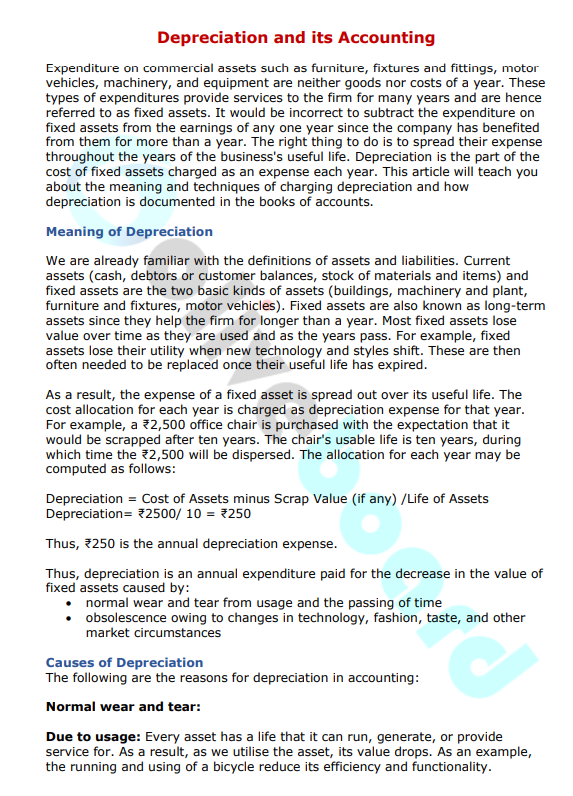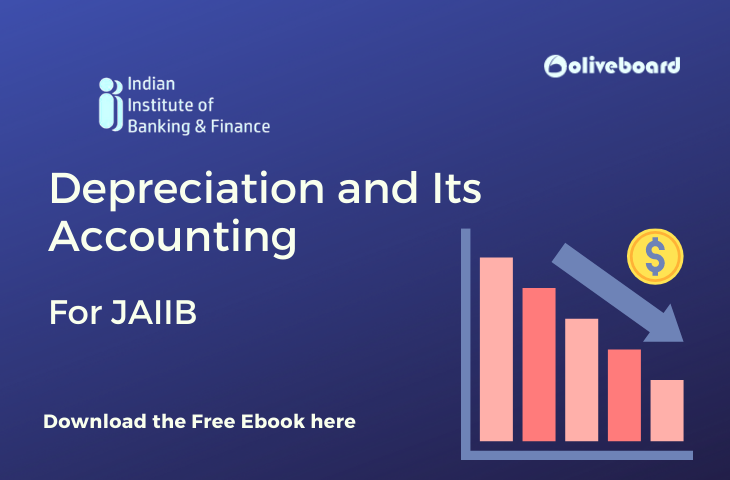Expenditure on commercial assets such as furniture, fixtures and fittings, motor vehicles, machinery, and equipment are neither goods nor costs of a year. These types of expenditures provide services to the firm for many years and are hence referred to as fixed assets. It would be incorrect to subtract the expenditure on fixed assets from the earnings of any one year since the company has benefited from them for more than a year. The right thing to do is to spread their expense throughout the years of the business’s useful life. Depreciation is the part of the cost of fixed assets charged as an expense each year. This article will teach you about the meaning and techniques of charging depreciation and how depreciation is documented in the books of accounts. Depreciation is the part of the cost of fixed assets charged as an expense each year. In this blog you will learn about Depreciation and Its Accounting, which is one of the important topic for JAIIB Exam! There are two JAIIB exams each year.
Download Depreciation And Its Accounting Free E-book
How to Download Depreciation And Its Accounting E-book for JAIIB?
Step 1: Click on the download link. You will be redirected to Oliveboard’s FREE E-Books Page.

Step 2: Create a free Oliveboard account or login using your existing Oliveboard account details
Step 3: Download the book by clicking on the link presented on the page.
Introduction
Expenditure on commercial assets such as furniture, fixtures and fittings, motor vehicles, machinery, and equipment are neither goods nor costs of a year. These types of expenditures provide services to the firm for many years and are hence referred to as fixed assets. It would be incorrect to subtract the expenditure on fixed assets from the earnings of any one year since the company has benefited from them for more than a year. The right thing to do is to spread their expense throughout the years of the business’s useful life. Depreciation is the part of the cost of fixed assets charged as an expense each year. This article will teach you about the meaning and techniques of charging depreciation and how depreciation is documented in the books of accounts.
Meaning of Depreciation
We are already familiar with the definitions of assets and liabilities. Current assets (cash, debtors or customer balances, stock of materials and items) and fixed assets are the two basic kinds of assets (buildings, machinery and plant, furniture and fixtures, motor vehicles). Fixed assets are also known as long-term assets since they help the firm for longer than a year. Most fixed assets lose value over time as they are used and as the years pass. For example, fixed assets lose their utility when new technology and styles shift. These are then often needed to be replaced once their useful life has expired.
As a result, the expense of a fixed asset is spread out over its useful life. The cost allocation for each year is charged as depreciation expense for that year. For example, a ₹2,500 office chair is purchased with the expectation that it would be scrapped after ten years. The chair’s usable life is ten years, during which time the ₹2,500 will be dispersed. The allocation for each year may be computed as follows:
Depreciation = Cost of Assets minus Scrap Value (if any) /Life of Assets Depreciation= ₹2500/ 10 = ₹250
Thus, ₹250 is the annual depreciation expense.
Thus, depreciation is an annual expenditure paid for the decrease in the value of fixed assets caused by:
- normal wear and tear from usage and the passing of time
- obsolescence owing to changes in technology, fashion, taste, and other market circumstances
Causes of Depreciation
The following are the reasons for depreciation in accounting:
Normal wear and tear
- Due to usage: Every asset has a life that it can run, generate, or provide service for. As a result, as we utilise the asset, its value drops. As an example, the running and using of a bicycle reduce its efficiency and functionality.
- Time: As time passes, natural forces such as wind, sun, and rain create physical degradation in the value of an object. As an example, the value of a piece of furniture decreases with time, even when it is not utilised.
Obsolescence
- Due to the development of improved or superior equipment: Because of the introduction of new or superior equipment, fixed assets are sometimes necessary to be removed before they are truly worn out due to either of the aforementioned causes. The arrival of improved equipment, machinery, and so on allows for the manufacture of things at a reduced cost. This renders older equipment obsolete, as the manufacture of items using them will be more expensive and less competitive. Steam engines, for example, became outdated with the introduction of diesel and electric locomotives.
- Due to change in fashion, style, taste or market conditions: Obsolescence may also occur as a consequence of a reduction in demand for specific goods and services as a result of a change in trend, style, taste, or market conditions. Goods and services that are no longer in demand reduce the value of the assets used to produce them, such as factories or equipment used to make vintage hats, shoes, and furniture. The loss in the value of fixed assets due to such factors is known as obsolescence, and it is also accounted for as depreciation.
Take a peek at the Depreciation and Its Accounting Free E-book

Conclusion
Depreciation is an important aspect of accounting records because it helps organizations keep their income statement and balance sheet accurate by recording the correct earnings. Using competent corporate accounting software can assist you in accurately recording depreciation without making human errors.
This was all about Depreciation and Its Accounting for JAIIB. Our goal is to provide candidates with information that will help them prepare for the JAIIB exam. Keep following Oliveboard for more updates. To stay updated, follow Oliveboard on Facebook and Telegram.
FAQs
A. To compute depreciation, this technique merely takes into account utilisation. However, various factors reduce the value of assets over time. This procedure may result in two distinct values for the same asset (depreciation and book value). This, in turn, may cause misunderstanding. Because it disregards the passage of time, this technique may fail to provide a correct depreciation value. This strategy does not apply to all enterprises, such as trade firms, the service sector, and so on. This form of depreciation is only available to manufacturers.
A. The following are the reasons for depreciation in accounting:
i) Normal wear and tear:
Due to usage
Time
ii) Obsolescence:
Due to the development of improved or superior equipment
Due to changes in fashion, style, taste or market conditions
JAIIB Study Material Compilation
Also Read:
- 5-Important Tips To Crack JAIIB Exams| Check Here (oliveboard.in)
- JAIIB Frequently Asked Questions- 2022| Check Here (oliveboard.in)
- JAIIB Genius | JAIIB Weekly Quiz PDF – JAIIB Questions PDF (oliveboard.in)
- JAIIB Full Form – Junior Associate of the Indian Institute of Bankers (oliveboard.in)
- JAIIB and CAIIB Books- Exams Syllabus, Books, and more (oliveboard.in)
Also Check:
- JAIIB 2022 Exam -Notification Released (oliveboard.in)
- JAIIB Notification 2022 – Notification PDF, Eligibility, (oliveboard.in)
- JAIIB Apply Online – Application Form 2022, Fees, Instru (oliveboard.in)
- JAIIB Eligibility – Age, Degree, Nationality, Members (oliveboard.in)
- JAIIB Syllabus – Complete List of Papers, Modules (oliveboard.in)
- JAIIB Exam Pattern 2022 – Details of Pattern, Marking (oliveboard.in)
- JAIIB Admit Card November 2022 – Steps and Direct Download (oliveboard.in)
- JAIIB 2022 Cut Offs – Check JAIIB Minimum Cut Off (oliveboard.in)

Hello there! I’m a dedicated Government Job aspirant turned passionate writer & content marketer. My blogs are a one-stop destination for accurate and comprehensive information on exams like Regulatory Bodies, Banking, SSC, State PSCs, and more. I’m on a mission to provide you with all the details you need, conveniently in one place. When I’m not writing and marketing, you’ll find me happily experimenting in the kitchen, cooking up delightful treats. Join me on this journey of knowledge and flavors!
